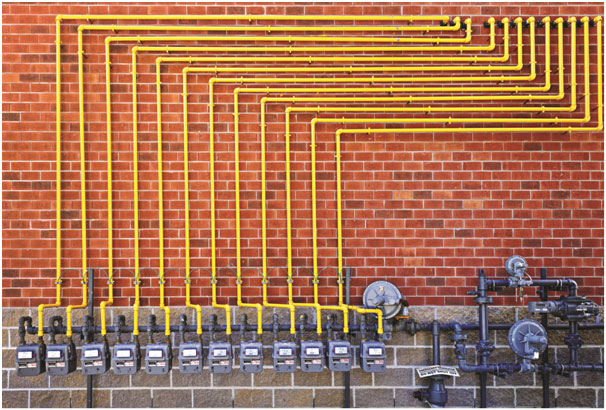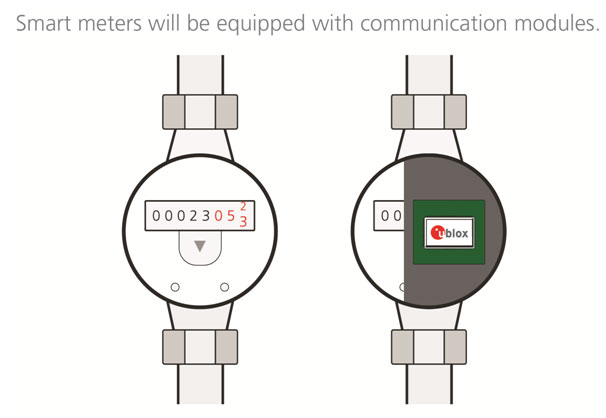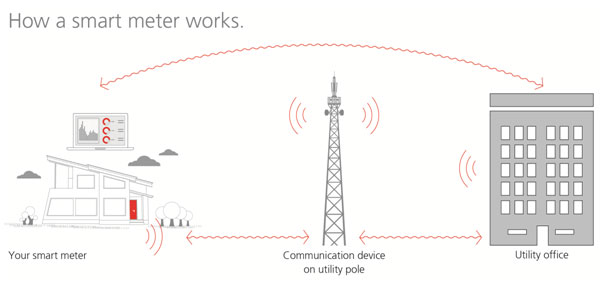By Diego Grassi, Senior Manager Market Development, u-blox
The smart, connected city is one of the most exciting aspects of the Internet of Things (IoT) that Really Matter.
We are told that the connected city is going to be a smarter city, but what does “smarter” actually mean in this context, and how will cities be connected? We don’t yet have all the answers to these questions, but public authorities, businesses, academic institutions, NGOs and individuals have, over the last few years, evolved a common understanding of what smart cities are and how they will evolve in the future. It is not a one-size-fits-all scenario, though. Geographic, cultural, financial and technical considerations will dictate priorities for the application of technology to the smart city concept.
 However, the unifying idea is that the smart city enhances the lives of its inhabitants. This may mean less traffic congestion and lower pollution, or the more effective supply of clean water. It can be a city where energy consumption and CO2 emissions are minimized, and one in which businesses are helped to thrive and public authorities can deliver better services for their citizens. The smart, connected city is one of the most exciting aspects of the Internet of Things (IoT) that Really Matter.
However, the unifying idea is that the smart city enhances the lives of its inhabitants. This may mean less traffic congestion and lower pollution, or the more effective supply of clean water. It can be a city where energy consumption and CO2 emissions are minimized, and one in which businesses are helped to thrive and public authorities can deliver better services for their citizens. The smart, connected city is one of the most exciting aspects of the Internet of Things (IoT) that Really Matter.
While definitions and applications are still evolving, it’s clear that the smart city concept embraces the supply of energy and water, transportation, infrastructures, the management of buildings and the work of municipal authorities. In all these areas, the multifaceted IoT enables us to collect data from an almost infinite variety of sensors and other sources, process that data locally or in the cloud, and initiate actions based on information derived from the data. The sensors, some of which will be location-aware, will communicate wirelessly with others around them and with gateways that link them to the cloud.
 Smart meters have already been installed in many municipalities around the world. These enable better management and monitoring of energy consumption, for both consumers and utility companies. Meter readings are instantly available to whoever needs them. Electricity, gas, oil and water consumption can be monitored locally or from anywhere in the world with an internet connection. Consumers program their electrical appliances to use off-peak energy, saving money and helping load-balancing on electricity grids. Utility companies no longer need to send people in vans to read their customers’ meters. Instead, data is collected remotely, accurately, at low cost and in real time. Some of this data can be used to inform predictive maintenance programs, improving reliability of supply while lowering operating and maintenance costs. Other data enables smarter management of the electricity grid, again reducing waste and saving money.
Smart meters have already been installed in many municipalities around the world. These enable better management and monitoring of energy consumption, for both consumers and utility companies. Meter readings are instantly available to whoever needs them. Electricity, gas, oil and water consumption can be monitored locally or from anywhere in the world with an internet connection. Consumers program their electrical appliances to use off-peak energy, saving money and helping load-balancing on electricity grids. Utility companies no longer need to send people in vans to read their customers’ meters. Instead, data is collected remotely, accurately, at low cost and in real time. Some of this data can be used to inform predictive maintenance programs, improving reliability of supply while lowering operating and maintenance costs. Other data enables smarter management of the electricity grid, again reducing waste and saving money.
Lighting accounts for nearly 20% of the world’s electricity consumption and by far the largest proportion of this is city lighting. However, smart city lighting, for example in streets and in car parks, can now be controlled automatically. Light is provided when it’s needed, but switched off to save energy when it’s not. Sensors detect both environmental conditions and traffic levels to determine the most appropriate illumination level for street lighting.
The automation of traffic control promises shorter, safer journeys and lower pollution levels. Emergency services will reach their destinations faster, saving lives, and businesses will operate more efficiently by reducing wasted travel time. Citizens will benefit too; travel should become less stressful and shorter commuter journeys may result in more leisure time. Smart parking services will mean driving directly to available spaces, rather than circling streets or car parks to find that illusive vacant space.
The volume of data being generated by smart cities is already immense and growing at an accelerating rate. Although there are legitimate concerns about security and privacy relating to individuals, much of the data will be generated and transmitted as machine-to-machine (M2M) communications. Some will inform municipal authorities in ways that enable them to optimize their work, either by saving money or facilitating new and improved services. For example, chemical sensors will monitor air quality, cameras will improve security, inductive sensors in roads will provide instant traffic updates and waste collection services will become more effective and efficient thanks to innovations such as smart bins, whose location and status can be monitored remotely.
Other information derived from smart city networks can be made available to consumers on websites, via mobile apps and on displays. Real time information on public transportation services is already displayed at bus stops and railway stations in some cities and businesses may also make use of smart city data to create targeted advertising, perhaps delivered to smart screens at transport terminals, shopping malls, and sports and entertainment facilities.
Of course, connected devices will require robust, secure communications at every point in the chain, from sensor nodes to the cloud and back again. This is where a plethora of wireless positioning and communications technologies come into play.
Global navigation satellite system (GNSS) are becoming more accurate, partly due to data fusion techniques that combine satellite signals with location information derived from cellular and Wi-Fi networks and, in the case of vehicles, data from wheel-tick sensors.
Familiar Wi-Fi and Bluetooth links, in a variety of flavors suited to different IoT applications, will proliferate, particularly where cellphones are used as internet gateways. Then there’s Narrowband IoT (NB-IoT), a new, ultra-low power technology for communicating small amounts of data over existing cellular radio networks. NB‑IoT has already been proven in a number of applications, including remote metering, where it eliminates the need for dedicated networks. Here, it facilitates rapid smart meter deployment with communications delivered over established, secure and reliable cellular networks that offer guaranteed quality of service. NB-IoT is particularly effective in challenging locations such as inside buildings, or even in cellars.
 For video and other high-bandwidth communications, high-speed, low latency 4G LTE networks are already playing a vital role. 5G is emerging too, and in the near future will increase network capacity and speeds by an order of magnitude. Communications links will be able to carry data from millions more sensors and consumer will be able to download Ultra HD videos in seconds.
For video and other high-bandwidth communications, high-speed, low latency 4G LTE networks are already playing a vital role. 5G is emerging too, and in the near future will increase network capacity and speeds by an order of magnitude. Communications links will be able to carry data from millions more sensors and consumer will be able to download Ultra HD videos in seconds.
u-blox’s unique heritage combines in-depth experience in positioning, short range wireless and cellular radio technologies, so the company is perfectly positioned to provision smart city wireless networks. u-blox’s integrated circuits and modules deliver secure, robust communications, whatever the environment. Equally important, modules are simple to install, scalable and easily upgraded as standards evolve. They also feature low power consumption, long operating life and minimal maintenance. As wireless standards develop, u-blox is playing a major role by participating in the most relevant industry bodies, enabling the company to keep its customers at the forefront of developments.
The smart city is bringing a better quality of life to hundreds of millions of citizens around the world and u-blox is delivering the connections that make it all possible in this vitally important aspect of the Internet of Things that Really Matter.
Below are five examples of smart cities in the making:
Bristol, UK
The Bristol Is Open initiative is explained as, “Using data sensors, smart city technologies will be able to respond in real-time to everyday events including congestion, waste management, entertainment events, e-democracy, energy supply and more”. Initiatives range from the council making its underground ducts and fiber optic networks accessible to service providers to participating in the REPLICATE project (Renaissance in Places with Innovative Citizenship And Technology) – a European research and development project that aims to deploy integrated energy, mobility and ICT solutions in city districts.
Georgia, US
The Georgia Power Company uses a power distribution technology that provides smart throttling of energy generation in response to demand fluctuations. It then offers its customers the option of a Smart Usage Rate to control their power bills by paying attention to which appliances are running and when they’re used in order to better manage demand.
Yinchuan, China
Yinchuan describes itself as “the premier Smart City capital of China”. The city administrators set themselves three objectives: to benefit people’s livelihoods, efficient administration, and industry derivation. Working with ZTE Corporation, the city has built a “Map-Network-Cloud” architecture to manage, among other things, government affairs, smart transportation and smart environment protection. 20,000 sets of servers process the city’s data.
Kigali, Rwanda
Started in Kigali, Smart Rwanda is a country-wide initiative to develop smart cities and smart villages that use information and communication technologies (ICT) to help tackle development challenges such as poverty, availability of basic services, and employment. The idea spread and the concept of Smart Africa came out of Kigali’s “Transform Africa Summit” held in October 2013. Smart Africa’s goal is to mobilize US$300 billion of investment in the ICT sector by 2020 to make the whole continent smarter.
Santiago, Chile
Santiago is home to 40% of Chile’s population of around 18 million people. In 2012, outgoing President Sebastián Piñera set a goal for Chile to become a developed nation, measured in terms of GDP per capita, by 2020. Santiago’s smart city initiatives are playing a central role with declared goals to “improve quality of life for its inhabitants by increasing access to energy, creating environmentally friendly smart homes, and emphasizing the use of sustainable energy”. Electronically controlled home appliances, installation of smart meters with two-way communication, and electronic information at bus stops all form part of the initiative.






